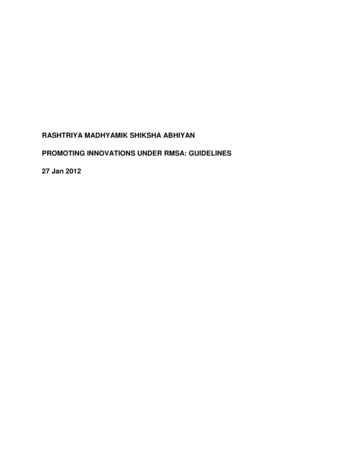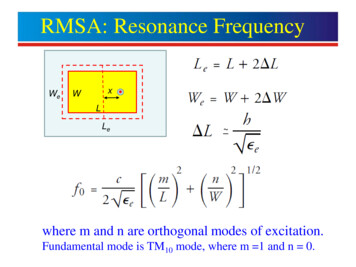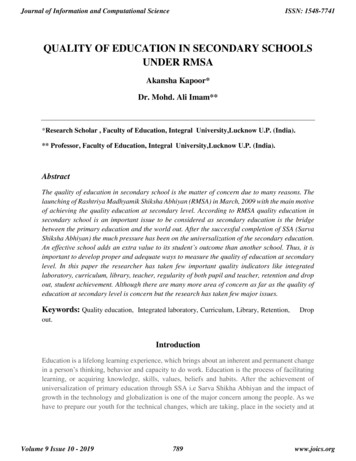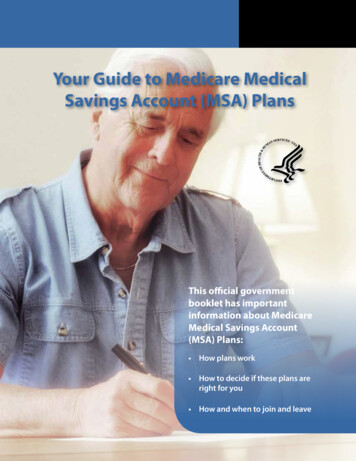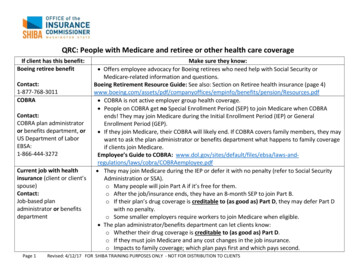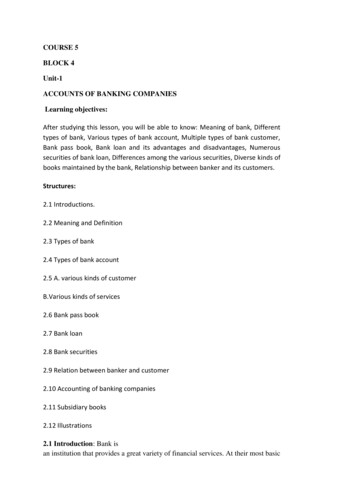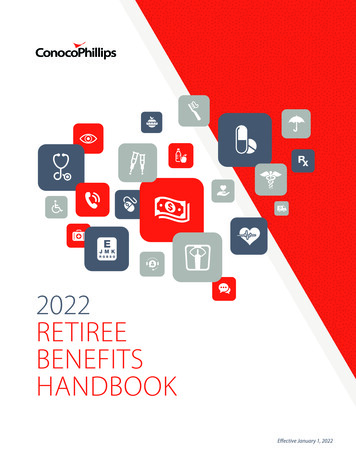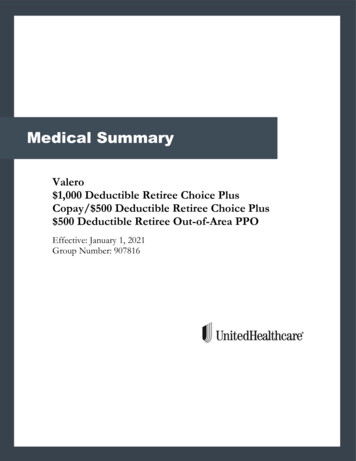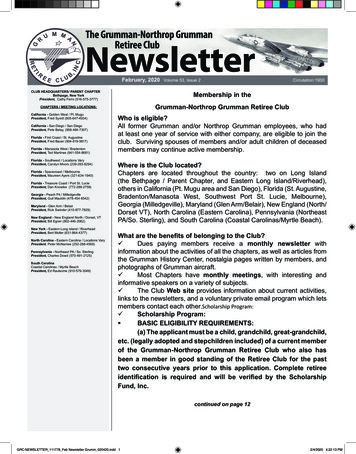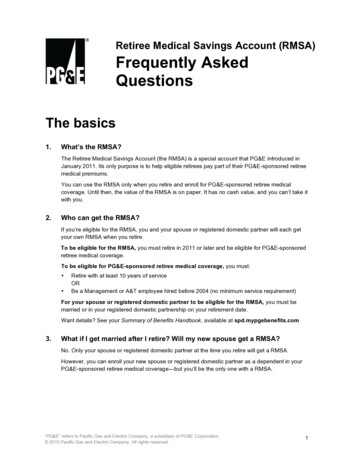
Transcription
!Retiree Medical Savings Account (RMSA)Frequently AskedQuestionsThe basics1.What’s the RMSA?The Retiree Medical Savings Account (the RMSA) is a special account that PG&E introduced inJanuary 2011. Its only purpose is to help eligible retirees pay part of their PG&E-sponsored retireemedical premiums.You can use the RMSA only when you retire and enroll for PG&E-sponsored retiree medicalcoverage. Until then, the value of the RMSA is on paper. It has no cash value, and you can’t take itwith you.2.Who can get the RMSA?If you’re eligible for the RMSA, you and your spouse or registered domestic partner will each getyour own RMSA when you retire.To be eligible for the RMSA, you must retire in 2011 or later and be eligible for PG&E-sponsoredretiree medical coverage.To be eligible for PG&E-sponsored retiree medical coverage, you must: Retire with at least 10 years of serviceORBe a Management or A&T employee hired before 2004 (no minimum service requirement)For your spouse or registered domestic partner to be eligible for the RMSA, you must bemarried or in your registered domestic partnership on your retirement date.Want details? See your Summary of Benefits Handbook, available at spd.mypgebenefits.com3.What if I get married after I retire? Will my new spouse get a RMSA?No. Only your spouse or registered domestic partner at the time you retire will get a RMSA.However, you can enroll your new spouse or registered domestic partner as a dependent in yourPG&E-sponsored retiree medical coverage—but you’ll be the only one with a RMSA.“PG&E” refers to Pacific Gas and Electric Company, a subsidiary of PG&E Corporation. 2015 Pacific Gas and Electric Company. All rights reserved.1
4.After I retire, what if my spouse or registered domestic partner dies—or wedivorce or terminate our domestic partnership? What happens to his or herRMSA?Your spouse or registered domestic partner’s RMSA will end, and the remaining balance will beforfeited. If you later remarry or register a new domestic partnership, you’ll need to pay the full costof coverage for your new spouse or registered domestic partner.5.If I cover an eligible child, will he or she have a separate RMSA?No. Children don’t get RMSAs. However, your own RMSA can help pay for your child’s PG&Esponsored coverage.Building your RMSA6.How does my RMSA grow?Your RMSA builds over time starting when you turn 45—or older, if you’re hired after 45.The amount PG&E contributes to your RMSA and to your spouse or registered domestic partner’sRMSA is based on your age and service. The more years of service you have and the older you arewhen you retire, the higher the value of your RMSA.Your RMSA—PG&E contributionsBefore you retireBefore and afteryou retireWhen you retireWhen you retireBased on ageBased on ageBased on serviceBased on service 5,000 a year toyour account Starts at age 45(later if hired after45) For each yearyou’re employedby PG&E from age45 onward 4.5% interest toyour account: Starts at age 46 Compoundedannually Extra 1,000 a yearto your account: For each full year ofcredited servicebeyond 15 years Includes creditedservice before age45 Up to an additionallump sum of 7,500to your account: Based on youryears of creditedservice Prorated from 10to 25 years ofservice Includes partialyearsYour RMSA gets the 5,000 annualallocation even ifyou’re employed foronly one day in thatyear.Interest is creditedas long as there’s abalance—evenafter you retire.Your RMSA gets the 1,000 annualallocation only for fullyears of creditedservice.Example: Unbrokenservice from July 15,2014, to July 15,2015, equals one fullyear of creditedservice.Continued on next page2
Your spouse or registered domestic partner’s RMSA—PG&E contributions*Before you retireBefore and after you retireBased on your ageBased on your age 5,000 a year to your spouse or registereddomestic partner’s account: Starts when you turn 45 (later if hiredafter 45) For each year you’re employed by PG&Efrom age 45 onward Includes partial yearsYour spouse or registered domestic partner’sRMSA gets the 5,000 annual allocation even ifyou’re employed for only one day in that year. 4.5% interest to your spouse or registereddomestic partner’s account: Starts when you turn 46 Compounded annuallyInterest is credited as long as there’s a balance—even after you retire.*For your spouse or registered domestic partner to be eligible for the RMSA, you must be married or in yourregistered domestic partnership on your retirement date.7.Can I add to my RMSA with my own contributions?No. Only PG&E can contribute to your RMSA. PG&E’s contributions have no cash value and canonly be used to help pay for your PG&E-sponsored retiree medical premiums.8.Can I watch my RMSA grow while I’m an employee?You can—starting December 31 of the year you turn 45. Log on to your Mercer BenefitsCentralaccount through PG&E@Work for Me or at mypgebenefits.com My Account Profile Retiree Savings Accounts.SMNo matter how old you are, you can model your estimated RMSA balance by entering differentretirement dates into the Modeling Tool at Mercer BenefitsCentral.9.Once I retire, will my RMSA get any additional credits?After you retire, your RMSA won’t get any new credits for age and service—but it will get 4.5%interest at the end of each year as long as there’s a balance. If your spouse or registered domesticpartner has a RMSA balance, it will be credited with 4.5% interest, too.Your RMSA will get the annual interest credit even if you’re not enrolled in a PG&E-sponsoredretiree medical plan when you retire.10. How do the different RMSA credits add up? I don’t understand how myRMSA is calculated.Your RMSA builds over time starting December 31 of the year you turn 45—but it only exists onpaper. You don’t actually get the RMSA—or any service-based credits—until you retire. And then,the RMSA has no cash value to you. It can only be used to offset part of your monthly premium forPG&E-sponsored retiree medical coverage.Continued on next page3
EXAMPLE: JOE Joe turned 45 July 4, 2005. He retired December 1, 2015, with 33 years of service. He started working for PG&E January 15, 1982, at age 22. He has no breaks in service.RMSA CREDITS BASED ON AGE1982 – 2004No RMSA until age 45Age 22 - 44 2005 5,000 annual allocation starting at age 45Age 45 Joe’s RMSA gets the first 5,000 allocation the year he turns 45. Joe will be able to see his RMSA balance on Mercer BenefitsCentral startingDecember 31 of the year Joe turns 45.Joe doesn’t have a RMSA balance because he’s not yet 45.2006 – 20144.5% interest, compounded annually, starting at age 46Age 46 - 54 Joe’s RMSA is credited with 4.5% interest, compounded annually every December31, starting at age 46. Joe’s RMSA will be credited with interest December 31, 2015, after he retiresDecember 1, 2015. Plus, Joe’s RMSA will be credited with interest in future years as long as there’s abalance.RMSA CREDITS BASED ON SERVICE1982 - 2015Up to 7,500 lump sum for 10 – 25 years of credited service—credited at retirement 1998 - 2015Joe’s RMSA gets the full 7,500 lump-sum credit because Joe retires with morethan 25 years of credited service.Extra 1,000 annual allocation for each full year of credited service beyond 15years Joe worked 15 years January 15, 1997—and he retired December 1, 2015.1998 - 2015 is the period that Joe’s RMSA is credited with the extra 1,000 annualallocation.At retirement, Joe’s RMSA is credited with 18,000 for the 18 years of full creditedservice he worked beyond his first 15 years.Continued on next page4
Here’s how Joe’s RMSA grows with compound interest.Note: These estimates are slightly different than the estimates available through the MercerBenefitsCentral Modeling Tool. Generally, the differences are less than a dollar.Year4.5% interest12/31/0512/31/0612/31/12 962.5912/31/13 1,230.9112/31/14 1,511.3012/1/15 33,584.46 35,095.76 5,000 1,804.31 40,095.76 41,900.07 5,000 2,110.50 46,900.07 49,010.57 5,000 2,430.4812/31/14 27,353.55 28,584.46 5,00012/31/13 21,390.96 22,353.55 5,00012/31/12 15,685.13 16,390.96 5,00012/31/11 10,225 10,685.13 705.8312/31/1012/31/11 5,225 5,00012/31/0912/31/10 5,000 460.1312/31/0812/31/09 5,000 5,00012/31/0712/31/08Joe’s balance 22512/31/0612/31/07New allocation 54,010.57 56,441.05 5,000 61,441.05Joe’s retirement date2015 allocation 5,000Lump sum at retirement 7,500Extra 1,000 for full years of credited service beyond15 years 18,000Joe’s RMSA balance at retirement 91,941.0511. Does a full year of service have to be a calendar year—January 1 toDecember 31?No. A full year of service just has to be 12 months without a break in service. For example, July 15,2015, to July 15, 2016, is a full year of service.5
12. I have a break in service. Will this affect my RMSA balance when I retire?It could. The 5,000 annual allocation starts when you turn 45, and the annual 4.5% interest startswhen you turn 46. If you’re 45 or older during your break in service, you’ll miss out on those credits.And for any partial years you work, your RMSA won’t get the 1,000 annual allocation. It’s only forfull calendar years of credited service.Age: The 5,000 annual allocation starts December 31 of the year you turn 45. The 4.5% annual interest starts December 31 of the year you turn 46.Service: The 1,000 annual allocation is only for full years of credited service beyond 15 years—notpartial years. It’s credited at retirement.EXAMPLES:STEVESteve resigned in 2011 at age 43, with 15 years of credited service.He was rehired into an eligible position in June 2015 at age 47.2011Steve doesn’t have a RMSA balance because he left PG&E before age 45.Age 43How it worksYou can’t get the 5,000 annual allocation until you’re 45.2015Age 47LISASteve came back to work in June 2015. Steve’s RMSA gets: 5,000 annual allocation for 2015 5,000 annual allocation for each additional year he works at PG&E Annual 4.5% interestLisa resigned in 2011 at age 46, with 15 years of credited service.She was rehired into an eligible position January 1, 2015, at age 50.2011 Lisa has a RMSA balance of 10,225 for the years she worked before she resigned.Age 46 Lisa’s RMSA is credited with the annual 4.5% interest even though she no longerworks for PG&E.Lisa’s RMSA is invisible to her because she’s no longer a PG&E employee and she’snot eligible for PG&E-sponsored retiree medical coverage.How it works RMSA balances get credited with 4.5% interest compounded annually, beginning at theend of the year in which you reach age 46.You can use the RMSA only when you retire and enroll for PG&E-sponsored retireemedical coverage. Until then, the value of the RMSA is on paper. It has no cash value, andyou can’t take it with you.2012 - 2014Lisa doesn’t work for PG&E—but her RMSA balance is still there.Ages 47 - 49 Lisa’s RMSA is credited with the annual 4.5% interest. Lisa’s RMSA will only be valuable to her if she comes back to work and later becomeseligible for PG&E-sponsored retiree medical coverage.2015Age 50Lisa is rehired January 1, 2015. Lisa’s RMSA gets: 5,000 annual allocation for 2015 5,000 annual allocation for each additional year she works at PG&E Annual 4.5% interest6
13. My co-worker and I ran RMSA estimates and are comparing our results. Wewere hired at the same time, and are thinking of retiring around the sametime. Why are our balances so different?There may be a few reasons: Age. The more years of service you have and the older you are, the higher the value of yourRMSA. In this case, if service is truly the same, one of you may be older than the other. Service. Did one of you have a break in service? This could have caused the 5,000 annualallocation to be missed for those break-in-service years. 5,000 a year can add up fast.Still have questions? Call the PG&E Benefits Service Center at 1-866-271-8144.14. My Retiree Medical Credited Service Date was adjusted to recognize myservice before I had a break in service. Will my break in service affect myRMSA balance?It could. Here’s how: 1,000 annual allocation. The Retiree Medical Credited Service Date determines the 1,000annual allocation for each full year of credited service beyond 15 years. If your Retiree MedicalCredited Service Date was adjusted to recognize your prior service, then your RMSA balancewill include the 1,000 annual allocations for full years of service. In other words, your break inservice won’t affect the 1,000 allocations for full years of service. 5,000 annual allocation. The adjustment to your Retiree Medical Credited Service Date hasno effect on the 5,000 annual allocation because that allocation is based on age andemployment history—not credited service. This means your RMSA balance could be affectedby breaks in service if you missed any of the 5,000 allocations.Using your RMSA15. Will the RMSA cover all of my retiree medical premiums?No. The RMSA pays for part of your PG&E-sponsored retiree medical premiums. You pay the rest.16. Can I use my RMSA to pay for non-PG&E retiree medical premiums—likeMedicare or coverage through my spouse’s plan at work?No. You can only use the RMSA to help pay for your PG&E-sponsored retiree medical premiums. Ifyou don’t have PG&E-sponsored coverage, the RMSA won’t pay anything.17. How much will the RMSA pay?The RMSA will pay a monthly percentage of your PG&E-sponsored retiree medical premium untilyour account is used up. The RMSA doesn’t pay a fixed dollar amount.For 2016 and beyond, the percentage the RMSA pays is based on Medicare eligibility:Not eligible for Medicare55% of the cost of coverageOREligible for Medicare30% of the cost of coverage7
18. Can I choose a different percentage for my RMSA to pay?No. The RMSA percentages are automatic. You can’t choose a different percentage.19. What if I’m eligible for Medicare and my enrolled child is not? How will myRMSA pay when the percentages are different?The RMSA payment for your child’s coverage will be based on your Medicare status. Your child’sMedicare status won’t matter when it comes to RMSA payments.EXAMPLES:A. You’re eligible for Medicare but your enrolled child is not. Your RMSA will pay theMedicare-eligible percentage for your child’s coverage—30%—the same as it pays for yourcoverage.B. You’re NOT eligible for Medicare but your enrolled child is. Your RMSA will pay the nonMedicare percentage for your child’s coverage—55%—the same as it pays for you.20. How much will I have to pay for my coverage?The actual dollar amount you have to pay for your PG&E-sponsored retiree medical coveragedepends on the total cost of your medical premium minus how much the RMSA pays.Usually, the amount you have to pay will be deducted automatically from your monthly pensionbenefit.You’ll get a monthly bill for your share of the cost if: Your monthly medical premium would take 85% or more of your monthly pension benefit; orYou don’t have a monthly pension benefit (an annuity)—but instead, you received a one-timelump-sum payout of your pension benefit; orYou don’t have a monthly pension benefit (an annuity) because you elected to defer collectingyour payment.EXAMPLE:These are sample calculations for you and an enrolled spouse or registered domestic partner:*Monthly premium 3,000Minus your RMSA payment– 1,000Minus your spouse or registered domestic partner’sRMSA payment– 700Equals the amount you pay 1,300*Dollar amounts are for illustration purposes only.21. Can I find out how much my premium might cost before I retire?Yes. You can model the cost of different medical plans and coverage levels with the RetireeMedical Estimator when you log on to your Mercer BenefitsCentral account via PG&E@Work forMe or at mypgebenefits.com. To talk with someone about your medical plan options or yourpremium costs, call the PG&E Benefits Service Center at 1-866-271-8144.8
22. Do I need 25 years of credited service to get the maximum contribution frommy RMSA toward my PG&E-sponsored retiree medical premium?No. Your credited service has nothing to do with how much the RMSA will pay. Your age and years of service affect how much your RMSA is worth (the balance when youretire). You would need 25 years of credited service to get the full 7,500 lump-sumcontribution to your RMSA at retirement. Your eligibility for Medicare determines what percentage the RMSA will pay toward your PG&Esponsored retiree medical premium.Want details? Please see question 17.23. Can I use my RMSA to pay for other out-of-pocket expenses like deductiblesand copayments?No. You can only use the RMSA to help pay for your PG&E-sponsored retiree medical premiums.24. Is there anything that can help me pay for out-of-pocket expenses?Maybe. If you answer “yes” to all of these questions, you’ll have help with your out-of-pocketexpenses in retirement: Were you enrolled in the Anthem or Kaiser Health Account Plan (HAP) as an employee?Did you have leftover Health Account credits when you retired?Are you eligible for PG&E-sponsored retiree medical coverage?If you answered “yes” to all of these questions, you can use your leftover Health Account credits tohelp pay for eligible out-of-pocket health expenses like deductibles and copayments. You can evenuse your leftover Health Account credits to help pay for PG&E-sponsored retiree medical premiumsand any Medicare Part B premiums.You don’t have to be enrolled in a PG&E-sponsored retiree medical plan to use your HealthAccount credits after you retire—you just need to be eligible for PG&E-sponsored retiree medicalcoverage.PG&E won’t contribute to your Health Account after you retire—and you can’t contribute to it, either.When your Health Account credits are used up, your Health Account will close.Remember, you can only use your RMSA to help pay for PG&E-sponsored retiree medicalpremiums—not for out-of-pocket expenses.25. What will happen to my RMSA if I waive PG&E-sponsored retiree medicalcoverage?Your RMSA will still be there for your future use if you ever decide to enroll in a PG&E-sponsoredretiree medical plan. Your account will continue to earn 4.5% interest each year as long as youhave a balance—whether or not you’re not enrolled in a PG&E-sponsored retiree medical plan.Later, when you enroll for PG&E-sponsored retiree medical coverage, your RMSA will start payingpart of your premiums.9
26. Can I decide not to use the RMSA and instead take cash?No. The RMSA automatically pays a percentage of your PG&E-sponsored retiree medical premiumevery month until your account is used up. The RMSA has no cash value—so the amount it paysisn’t taxable.27. Will my RMSA keep paying throughout my retirement?It could if you have enough in your RMSA. However, once your account is used up, the RMSAstops paying. At that point, you’ll be responsible for paying 100% of your PG&E-sponsored retireemedical premium costs.28. How long will my RMSA last?How long your RMSA will last depends on: How much it’s worth when you retire (the amount PG&E contributes to your RMSA is based onyour age and service when you retire) How soon your enroll for PG&E-sponsored retiree medical coverage and start using yourRMSA The rate of medical plan inflation The cost of the medical plans you elect Whether you enroll eligible children (part of their cost for coverage comes out of your RMSA)29. Can I elect PG&E-sponsored retiree medical coverage but defer using myRMSA so it will last longer?No. PG&E-sponsored retiree medical coverage and the RMSA go together. If you elect coverageand have a RMSA balance, your RMSA will be used automatically.30. What will happen to my RMSA when I die?You’ll forfeit your unused RMSA balance when you die.If your spouse or registered domestic partner has a remaining RMSA balance and isn’t eligible forMedicare, he or she can continue to use the RMSA to help pay for PG&E-sponsored retireemedical premiums for him or herself and for any eligible dependent children.Your spouse or registered domestic partner can use his or her own RMSA until the RMSA is usedup or until he or she becomes ineligible for PG&E coverage—whichever occurs first. Your survivingspouse or registered domestic partner will become ineligible for PG&E coverage when he or she: Becomes eligible for Medicare Remarries or enters into a registered domestic partnership Becomes eligible for other employer-sponsored medical coverage Choose to decline PG&E-sponsored medical coverage31. I still have questions. Where can I get help with my RMSA? Call the PG&E Benefits Service Center at 1-866-271-8144. Representatives are availableMonday through Friday, 7:30 a.m. to 5 p.m. Pacific time. Log on to your Mercer BenefitsCentral account via PG&E@Work for Me or atmypgebenefits.com. You can use the Modeling Tool to see how much your RMSA might beworth when you enter different retirement dates, and you can estimate your costs for PG&Esponsored retiree medical coverage.10
Joe doesn't have a RMSA balance because he's not yet 45. 2005 Age 45 5,000 annual allocation starting at age 45 Joe's RMSA gets the first 5,000 allocationthe year he turns 45. Joe will be able to see his RMSA balance on Mercer BenefitsCentral starting December 31 of the year Joe turns 45. 2006 - 2014 Age 46 - 54
